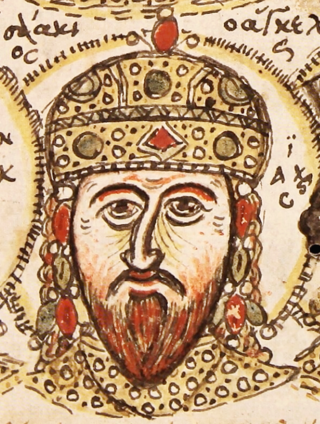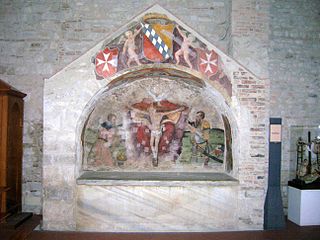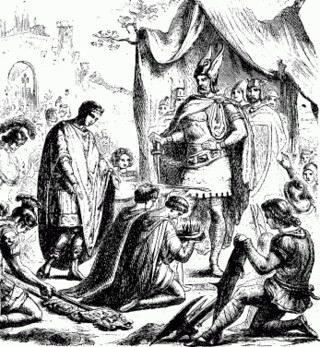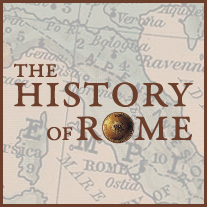
Constantinople became the capital of the Roman Empire during the reign of Constantine the Great in 330. Following the collapse of the Western Roman Empire in the late 5th century, Constantinople remained the capital of the Eastern Roman Empire, the Latin Empire (1204–1261), and the Ottoman Empire (1453–1922). Following the Turkish War of Independence, the Turkish capital then moved to Ankara. Officially renamed Istanbul in 1930, the city is today the largest city and financial centre of Turkey. It is also the largest city in Europe.
Year 1108 (MCVIII) was a leap year starting on Wednesday of the Julian calendar.

Isaac II Angelos or Angelus was Byzantine Emperor from 1185 to 1195, and again from 1203 to 1204.

Michael V Kalaphates was Byzantine emperor for four months in 1041–1042. He was the nephew and successor of Michael IV and the adoptive son of Michael IV's wife Empress Zoe. He was popularly called "the Caulker" (Kalaphates) in accordance with his father's original occupation.

Tancred was King of Sicily from 1189 to 1194. He was born in Lecce an illegitimate son of Roger III, Duke of Apulia by his mistress Emma, a daughter of Achard II, Count of Lecce. He inherited the title "Count of Lecce" from his grandfather and is consequently often referred to as Tancred of Lecce. Due to his short stature and unhandsome visage, he was mocked by his critics as "The Monkey King".

The Roman emperor was the ruler and monarchial head of state of the Roman Empire during the imperial period, starting with the granting of the title augustus to Octavian in 27 BC. The emperors used a variety of different titles throughout history. Often when a given Roman is described as becoming emperor in English, it reflects his taking of the title augustus and later basileus. Another title often used was caesar, used for heirs-apparent, and imperator, originally a military honorific. Early emperors also used the title princeps civitatis. Emperors frequently amassed Republican titles, notably princeps senatus, consul, and pontifex maximus.

The Principality of Antioch was one of the crusader states created during the First Crusade which included parts of modern-day Turkey and Syria. The principality was much smaller than the County of Edessa or the Kingdom of Jerusalem. It extended around the northeastern edge of the Mediterranean, bordering the County of Tripoli to the south, Edessa to the east, and the Byzantine Empire or the Kingdom of Armenia to the northwest, depending on the date.

Ptolemy XIV Philopator was a Pharaoh of the Ptolemaic Kingdom of Egypt, who reigned from 47 until his death in 44 BC.

William I of Hauteville, known as William Iron Arm, was a Norman adventurer who was the founder of the fortunes of the Hauteville family. One of twelve sons of Tancred of Hauteville, he journeyed to the Mezzogiorno with his younger brother Drogo in the first half of the eleventh century (c.1035), in response to requests for help made by fellow Normans under Rainulf Drengot, count of Aversa.

The term Norman–Arab–Byzantine culture, Norman–Sicilian culture or, less inclusively, Norman–Arab culture, refers to the interaction of the Norman, Byzantine Greek, Latin, and Arab cultures following the Norman conquest of the former Emirate of Sicily and North Africa from 1061 to around 1250. The civilization resulted from numerous exchanges in the cultural and scientific fields, based on the tolerance shown by the Normans towards the Latin- and Greek-speaking Christian populations and the former Arab Muslim settlers. As a result, Sicily under the Normans became a crossroad for the interaction between the Norman and Latin Catholic, Byzantine–Orthodox, and Arab–Islamic cultures.

The Byzantine Empire, also referred to as the Eastern Roman Empire, was the continuation of the Roman Empire primarily in its eastern provinces during Late Antiquity and the Middle Ages, when its capital city was Constantinople. It survived the fall of the Western Roman Empire in the 5th century AD and continued to exist until the fall of Constantinople to the Ottoman Empire in 1453. During most of its existence, the empire remained the most powerful economic, cultural, and military force in the Mediterranean world. Its citizens continued to refer to their empire as the Roman Empire and to themselves as Romans—a term which Greeks continued to use for themselves into Ottoman times. Modern historians distinguish the Byzantine Empire from the earlier Roman Empire due to the imperial seat moving from Rome to Byzantium, the Empire's integration of Christianity, and the predominance of Greek instead of Latin.

This history of the Byzantine Empire covers the history of the Eastern Roman Empire from late antiquity until the Fall of Constantinople in 1453 AD. Several events from the 4th to 6th centuries mark the transitional period during which the Roman Empire's east and west divided. In 285, the emperor Diocletian partitioned the Roman Empire's administration into eastern and western halves. Between 324 and 330, Constantine I transferred the main capital from Rome to Byzantium, later known as Constantinople and Nova Roma. Under Theodosius I, Christianity became the Empire's official state religion and others such as Roman polytheism were proscribed. Finally, under the reign of Heraclius, the Empire's military and administration were restructured and adopted Greek for official use instead of Latin. Although the Roman state continued, some historians choose to distinguish the Byzantine Empire from the earlier Roman Empire due to the imperial seat moving from Rome to Byzantium, the Empire’s integration of Christianity, and the predominance of Greek instead of Latin.
In 395, the Roman Empire was permanently divided and the area that now constitutes modern Albania became part of the Byzantine Empire.

The Normans were a population arising in the medieval Duchy of Normandy from the intermingling between Norse Viking settlers and indigenous West Franks and Gallo-Romans. The term is also used to denote emigrants from the duchy who conquered other territories such as England and Sicily. The Norse settlements in West Francia followed a series of raids on the French northern coast mainly from Denmark, although some also sailed from Norway and Sweden. These settlements were finally legitimized when Rollo, a Scandinavian Viking leader, agreed to swear fealty to King Charles III of West Francia following the siege of Chartres in 911. The intermingling in Normandy produced an ethnic and cultural "Norman" identity in the first half of the 10th century, an identity which continued to evolve over the centuries.

The following outline is provided as an overview of and topical guide to the Byzantine Empire:

Odoacer's deposition of Romulus Augustus, occurring in 476 AD, was a coup that marked the end of the reign of the Western Roman Emperor last approved by the Western Roman Senate and the creation of the Kingdom of Italy, although Julius Nepos exercised control over Dalmatia until 480. Romulus Augustus was a 16-year-old minor at the time.

The History of Rome, often abbreviated THoR, was a podcast created by Mike Duncan which aired between 2007 and 2012. In the 2010 podcast awards, THoR won best educational podcast. THoR covers the time period from the origin of the Roman Kingdom to the Fall of the Western Roman Empire, focusing on the most accepted chain of events according to historical consensus.

The problem of two emperors or two-emperors problem is the historiographical term for the historical contradiction between the idea of the universal empire, that there was only ever one true emperor at any one given time, and the truth that there were often multiple individuals who claimed the position simultaneously. The term is primarily used in regards to medieval European history and often refers to in particular the long-lasting dispute between the Byzantine emperors in Constantinople and the Holy Roman emperors in modern-day Germany and Austria as to which monarch represented the legitimate Roman emperor.
Anthony Kaldellis is a Greek and American historian who is Professor and a faculty member of the Department of Classics at the University of Chicago. He is a specialist in Greek historiography, Plato and Byzantine Studies. He is also the author of numerous monographs on classical antiquity and the Byzantine Empire, which have been translated into many languages. Throughout his work Kaldellis have called into question a commonly accepted view of Byzantium as an absolutist world; he consideres instead the Byzantine Empire a "bottom-up monarchy", where the common people have a good share in government, since Emperors impose laws by acknowledging their customs and demands.

The Ottoman claim to Roman succession was first revealed by Bayezid I, who called himself sultan-i Rûm, claiming that he was the heir of the Sultanate of Rûm. After the conquest of Constantinople in 1453, the sultans of the Ottoman Empire laid claim to be the legitimate Roman emperors, in succession to the Byzantine emperors who had previously ruled from Constantinople. Based on the concept of right of conquest, the sultans at times assumed the styles kayser-i Rûm and basileus. The assumption of the heritage of the Roman Empire also led the Ottoman sultans to claim to be universal monarchs, the rightful rulers of the entire world.
















